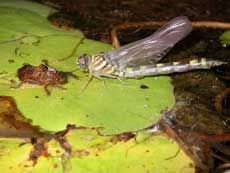Major Group: Insecta
Order: Odonata
Family: Lindeniidae (formerly part of Gomphidae)
Genus: Ictinogomphus
This family is represented in Australia by a single genus, Ictinogomphus. |
Descriptive Features: all tarsi 2-segmented
abdomen deep and almost as wide as long
antennae slim, segment 4 greatly reduced, often retracted into long segment 3, segment 3 reaching almost to tip of labrum
labium reaching back to level of inner, ventral ridge on procoxa
prementum approximately as wide as long
ligula evenly curved, regularly toothed, fringed with setae, long on lateral margin
palps curved, dentate on inner margin, end hook bluntly pointed
wing sheaths reaching end of segment 5 or on to segment 6
abdomen hardly longer than wide, widest at segment 6
large lateral spines on segments 7-9, smaller lateral spines on segments 3-6, decreasing in size from rear to front
large middorsal hooks on segments 1-9, dorsal hook on segment 1 varying in size from low tubercle to small upright spike
bases of dorsal hooks on segments 2-5 occupying approx. ½ length of tergum, or less, hooks upright on segments 2-3 or backward-sloping spikes on segments 4-5, hooks on segments 6-9 terminating
strong middorsal ridge on each abdominal segment, highest on segment 7
epiproct 20-25% longer than paraprocts and cerci
Total length: 23.0 - 28.0 mm |

|
Ictinogomphus australis |
|
|

|
Ictinogomphus australis |
|
Taxonomic Checklist: Species
(not all nymphs known)
Ictinogomphus australis (Selys, 1873)
Ictinogomphus dobsoni (Watson, 1969)
Ictinogomphus paulini Watson, 1991 |
|
Distribution: NSW, Qld, NT, WA
Sensitivity Rating: SIGNAL grade 3
Functional Feeding Group: predators |

|
South Alligator River, Kakadu NT |
|
|
Ecology: Adults are commonly known as 'tigers or wingtails'.
Instream habitat: Ictinogomphus larvae occur in rivers, riverine lagoons and ponds, shallowly burrowing in mud and sand.
Feeding ecology: Larvae are predators.
Habit:
Life history: Ictinogomphus species breed in still or sluggish waters. |
| |
Information Sources: Theischinger & Endersby 2009, Theischinger 2000, Houston 1988, Theischinger & Hawking 2006
Key to Species: Theischinger & Endersby 2009 |

|
emerging from the larval form |
|

|
teneral adult |
|

|
drying the wings |
|

|
exuvia and new adult |
|
|
|
|